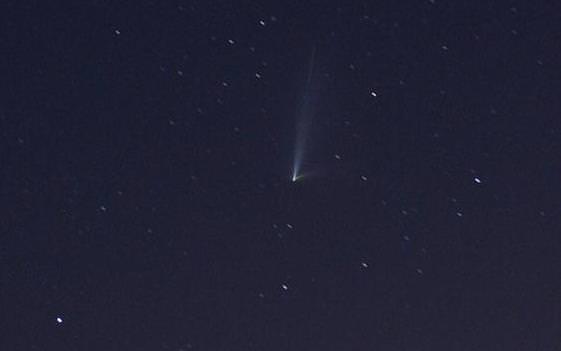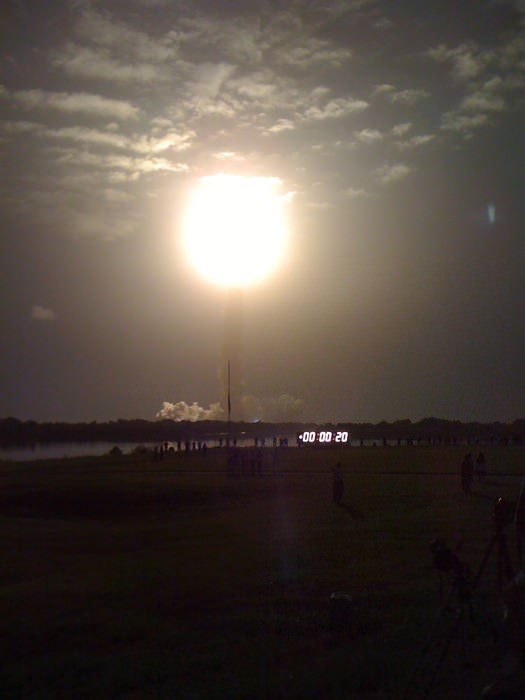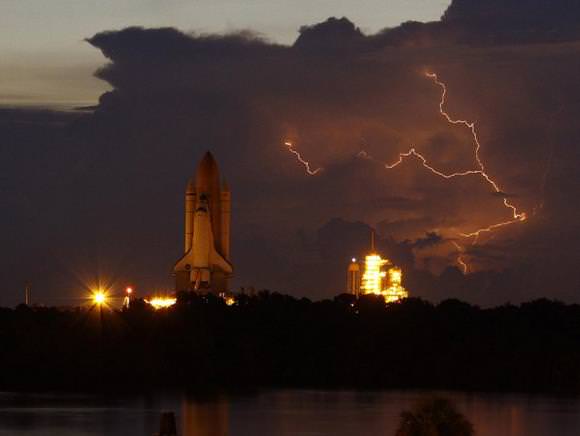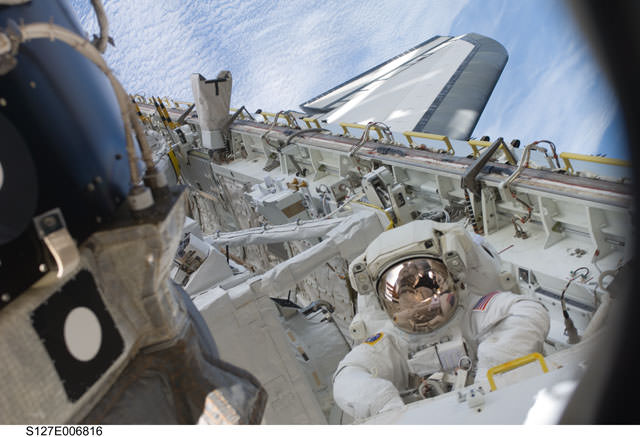With the shuttle retirement looming, you never know if or how often you’re going to see this sight again. So enjoy these two videos of the shuttle hitching a piggyback ride back to Kennedy Space Center atop a modified 747. Space shuttle Discovery left Edwards Air Force Base in California on Sunday, Sept. 20 and arrived at KSC today, the 21st. Top, is the 747/shuttle landing at KSC (it gets good about 1:20 in) and below is really pretty footage of the duo getting ready to leave Edwards just at dawn, and the lighting is just plain gorgeous.
Continue reading “Spectacular Videos of Shuttle Piggyback Flight”
Space Shuttle Flushes the Toilet for All the World To See
[/caption]
This picture is from last week; September 9, 2009 to be exact, but I still wanted to share it. I just got in touch with photographer Clair Perry from Prince Edward Island, Canada to get his permission to post the image. No, this is not a comet. Pictured is space shuttle Discovery executing a water dump. The shuttle needed to get rid of excess waste water before landing the next day, and jettisoned it overboard via the waste water dump line, creating a spectacular visual effect as sunlight hit the spraying water. This dump occurred just as the shuttle was flying over North America last week, and lots of people witnessed this “toilet flush.” Some reports indicated it was “pristine” water (the shuttle fuel cells’ by-product is water) and other reports said it was “waste water and urine” (the Bad Astronomer called it Constellation Urion). Whatever, it was pretty. NASA said this was an unusually large dump, about 150 pounds (68 kg), because new regulations say no shuttle water dumps can take place while docked to the ISS, so as not to contaminate the outdoor experiments on the Kibo lab.
See below for the spectacular entire image, which also includes the nearby ISS creating a streak in the sky. Thanks to Clair Perry for sharing his images.
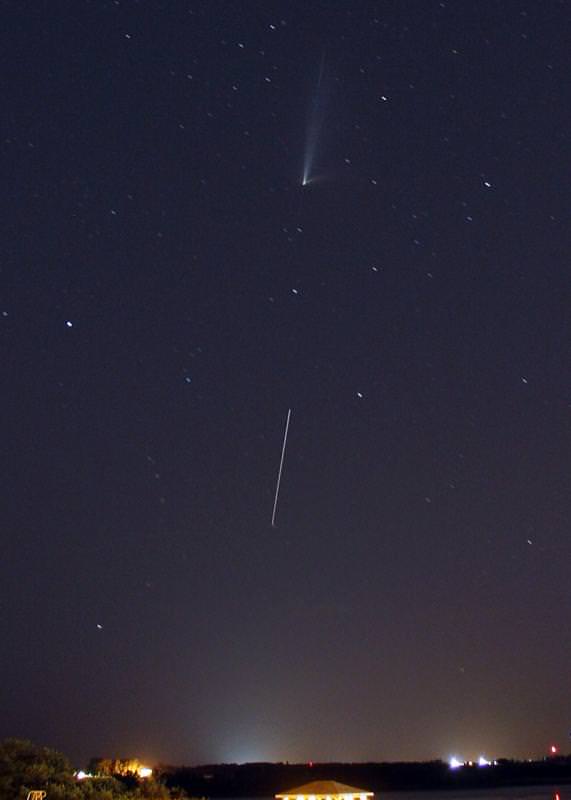
And if you’re worried about the water ice freezing and becoming projectiles in orbit, NASA says that while waste water usually freezes upon jettison into a cloud of tiny ice droplets, when the sun hits, the ice sublimates directly into water vapor and disperses in space.
I remember the first time I saw a shuttle water dump. It was back in 2000, and I had gotten up early, about 4:45 am, to watch the shuttle pass over. But I saw this strange sight, like something was coming off of the shuttle. I ran inside and turned on NASA TV, just in time to see a view of a golden spray shooting out of the shuttle — the sunlight hitting the water at just the right angle made it look like a shimmering gold spray. Gold, not yellow.
ISS Tracking
[/caption]
The International Space Station, or ISS, is the largest object every built by humans in space. And because it’s so large, it’s also very bright; easily visible with the unaided eye. The ISS also follows an orbital track that takes over different parts of the Earth. That means if you know the right time, you can go out and watch the station pass right over. But you need to know the right time, and that requires some kind of ISS tracking tool. Let’s take a look at some ISS tracking tools you can use to tell you when you should head outside and look up.
The best place to track ISS is from NASA’s human space flight ISS tracking page. This site will tell you the current location of the International Space Station, and space shuttles currently in flight, and the Hubble Space Telescope. The problem is that this tells you where the space station is right now, and not when it’s going to be passing through your skies… at night.
A better tool for that is the ISS sightings page. You download an applet that lets you put in your place on Earth and it gives you some upcoming dates and times that the station will be passing overhead. There’s also a quick drop down box, where you can select your location from many places in the world.
Another great tool is Heavens Above. It allows you to track the current position of thousands of satellites, including ISS and the space shuttles, when they’re in orbit.
So use one of these tools for ISS tracking, and then head outside and see if you can see the station with your own eyes.
We have written many articles about the International Space Station. Here’s an article about how you can actually see ISS in the daytime; it’s just that bright. And here’s an image of ISS and the shuttle transiting the Sun.
We have recorded an episode of Astronomy Cast that talks about the Space Station’s orbit.
COLBERT, Leonardo and a Neutralino Heading for Space Station
[/caption]
The third launch attempt was a charm for space shuttle Discovery and her crew. The STS-128 mission is now underway with a successful liftoff one minute before midnight, local time, from Kennedy Space Center. Discovery is carrying the Leonardo supply module to the International Space Station, and tucked away inside is the COLBERT treadmill, along with several refrigerator-sized racks of science equipment, a freezer to store research samples, a new sleeping compartment, an air purification system, and other supplies, plus another unusual object packed in Swedish astronaut Christer Fuglesang’s belongings: a theoretical particle called a neutralino.
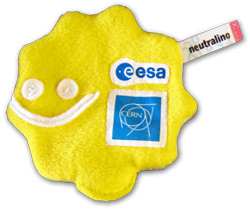
As you may have guessed, Fugelsang didn’t bring a real neutralino, but a soft toy version (see the whole collection of particles at Particle Zoo.) Fugelsang is a former CERN physicist and he wanted to take something representing CERN up to space on his mission. He chose the neutralino because it links together astrophysics and particle physics. In particle physics, the neutralino is a hypothetical particle, one of many predicted by supersymmetric theories.
The countdown and launch were textbook, without any hitches or delays. The valve that scrubbed a launch attempt earlier this week behaved normally, and while weather (which forced the first launch scrub) was a concern early during the countdown, the Florida skies eventually cleared allowing for a gorgeous nighttime liftoff. The stunning lead image is courtesy of flyingjenny on Twitter. Click the image for more of her images. Several comments from Twitterers attending the launch said night was turned into day as the shuttle ascended!
The mission is commanded by veteran astronaut Rick “C.J.” Sturckow. With him are pilot Kevin Ford and Mission Specialists Patrick Forrester, Jose Hernandez, John “Danny” Olivas, and Fugelsang, along with a new crew member for the station, Nicole Stott.
Of course, the treadmill is named after comedian Stephen Colbert, (if you’ve been living under a rock and haven’t heard about this, read about it here) and otherwise is called the Combined Operational Load Bearing External Resistance Treadmill.
Discovery is scheduled to dock with the ISS on Sunday August 30.
Sources: NASA TV, CERN
How Close Was That Lightning to the Shuttle?
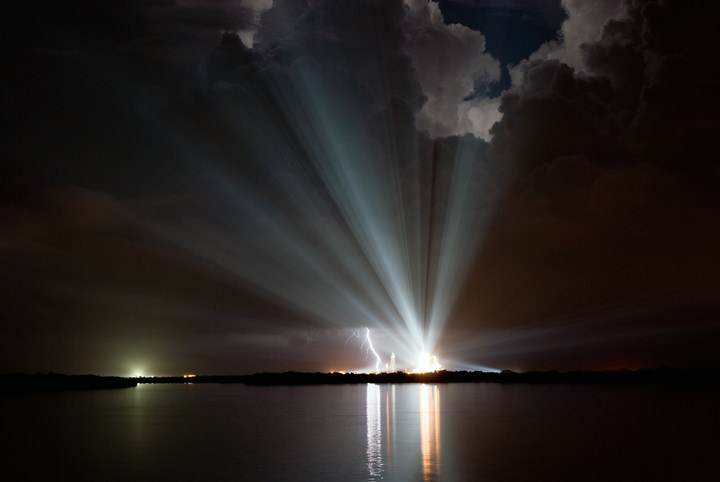
[/caption]
If you’re wondering why the first launch attempt for space shuttle Discovery was scrubbed early Tuesday morning, here’s your answer. Yikes! But what a gorgeous picture! And of course, the second launch attempt early Wednesday morning was called off when instrumentation for an 8-inch fill and drain valve on the shuttle’s external tank indicated the valve had failed to close. But yesterday, the valve functioned correctly five times during launch pad tests, NASA said. That means NASA will likely go ahead with a launch attempt at 04:22 GMT (12:22 a.m. ET) on Friday. But the anomaly remains unexplained, so it will be up to the mission management team to decide if the shuttle can fly as is, or if engineers need to know more about the issue. The decision won’t be made, however until the MMT meets Thursday afternoon, just hours before the scheduled liftoff time. As the saying goes, there’s a million parts on the shuttle and if only one is not working….
UPDATE: Launch now is targeted for no earlier than 11:59 p.m. Friday, Aug. 28, to allow engineers more time to develop plans for resolving the issue with the valve.
See below for a close-up of the lightning shot, to see how close it actually came to the shuttle.
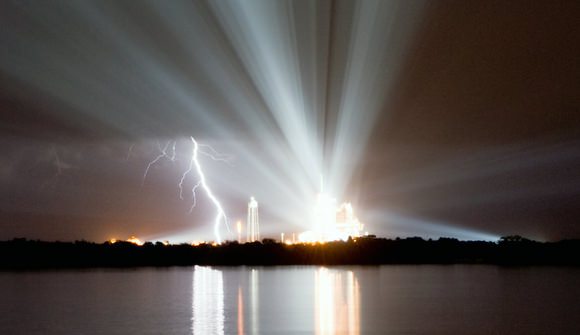
Discovery’s 13-day mission will deliver more than 7 tons of supplies, science racks and equipment, as well as additional environmental hardware to sustain six crew members on the International Space Station. The equipment includes a freezer to store research samples, a new sleeping compartment and the COLBERT treadmill. The mission is the 128th in the Space Shuttle Program, the 37th flight of Discovery and the 30th station assembly flight.
Hat Tip to absolutespacegrl on Twitter!
South Korea Launch No Go, Shuttle Launch a Go
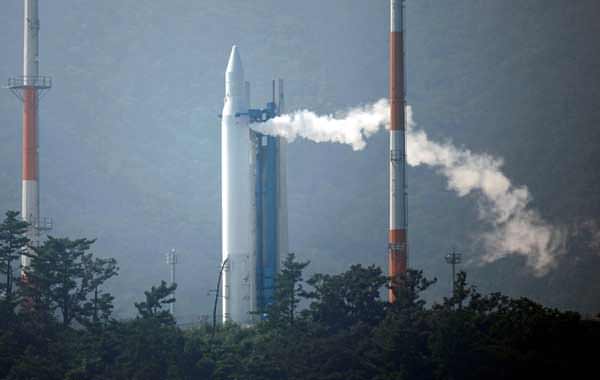
[/caption]
The launch of South Korea’s first domestic rocket launch was aborted on Wednesday just minutes before scheduled liftoff because of a technical problem, delaying South Korea’s mini space race with North Korea. The two-stage rocket, called the Naro will be South Korea’s first launch from its own territory. Officials expect another liftoff will be attempted in a few days. Another launch attempt on July 30 was also aborted. The satellite was domestically built, with help from Russia and will observe the atmosphere and ocean. The launch attempt came about four months after North Korea was widely criticized for firing its own rocket in defiance of United Nations sanctions.
Meanwhile, NASA officials have cleared space shuttle Discovery to launch on August 25 for the STS-128 mission to the International Space Station. As of now, weather is the only issue that might delay the mission.

Discovery will carry the Leonardo supply module to the International Space Station during STS-128, along with a new crew member for the station, Nicole Stott.
Launch is set for 1:36 am EDT (yes, that’s EXTREME am!) on the 25th. The good news about that hour is that launch should come well before any typical afternoon storms can brew up in the Florida skies. But then, it is hurricane season, and NASA is keeping an eye on a few tropical storms on the horizon.
Commanded by veteran astronaut Rick “C.J.” Sturckow, the STS-128 mission crew will deliver refrigerator-sized racks full of equipment, including the COLBERT treadmill, an exercise device named after comedian Stephen Colbert.
Stott will take the place of Tim Kopra, who moved into the station during STS-127. Pilot Kevin Ford and Mission Specialists Patrick Forrester, Jose Hernandez, John “Danny” Olivas and Sweden’s Christer Fuglesang round out the crew.
Sources: Discovery News, NASA
There Was a Reason Discovery’s Rollout Took Longer Than Usual…
[/caption]
Yikes! No wonder the rollout of space shuttle Discovery took a little bit longer than usual. Lightning lit up the sky above Kennedy Space Center early Tuesday morning, providing a stunning backdrop for the shuttle’s crawl to the launchpad. Usually the trip takes about six hours, but various weather-related concerns slowed the move out past 11 hours. Lightning delayed Discovery’s exit from the Vehicle Assembly Building for about 2 hours, and then mud from recent thunderstorms forced the crawler to stop repeatedly so engineers could clean out the giant treads on the huge 5.5 million-pound (2.4 million-kg) vehicle that hauls shuttles out to the launch pad. Discovery is scheduled to launch on August 25 for the STS-128 mission to the ISS. Of interest is that this mission will bring the C.O.L.B.E.R.T treadmill to the station, an exercise device named after comedian Stephen Colbert.
Discovery will carry the Leonardo supply module to the International Space Station during STS-128, along with several refrigerator-sized racks with equipment and supplies, and a new crew member for the station, Nicole Stott. The mission will be commanded by veteran astronaut Rick “C.J.” Sturckow, along with Pilot Kevin Ford and Mission Specialists Patrick Forrester, Jose Hernandez, John “Danny” Olivas and Sweden’s Christer Fuglesang.
Source: NASA
Endeavour Lands Safely (Video)
Space shuttle Endeavour and its crew of seven astronauts ended their 16-day mission by landing safely at Kennedy Space Center in Florida. If you missed seeing it live, watch the picture-perfect landing here. Good weather allowed the crew to come home on the first landing opportunity, after their orbital journey of more than 6.5 million miles. Endeavour touched down at 10:48 a.m. EDT, the 71st shuttle landing at KSC. It was the 23rd flight for Endeavour, the 127th space shuttle mission and 29th shuttle flight to the International Space Station.
Continue reading “Endeavour Lands Safely (Video)”
Triple Spaceship Sighting Alert!
[/caption]
A great opportunity tonight (July 28) to see three spaceships cross the sky at once! Endeavour just undocked from the ISS today, so they will be close to each other, plus there’s another spaceship lurking nearby: a Progress re-supply ship ready to dock with the ISS. How can you find out when and where to look for the three spacecraft? There are a couple of different websites that provide real-time tracking data and information about the ISS sighting opportunities. See below for more info.
The image above is a screenshot from NASA TV of the ISS as Endeavour undocked. Notice the shadow of the shuttle on the ISS solar arrays!
NASA has a Quick and Easy Sightings by City site, where you just search for your country and city which provides local times and the location in the sky where the station will be visible.
The European Space Agency also provides their ISS: Where Is It Now site that also allows you to select your country and city to find the station’s location.
The Heaven’s Above website (which also powers ESA’s site) is also an excellent site to find out when the ISS, as well as all sorts of other satellites and other heavenly sights will be visible. At Heaven’s Above, you can plug in your exact latitude and longitude, so if you live in a remote area, you’ll be able to have exact times and locations to look for satellites instead of relying on information for the nearest city.
There’s also this very cool Google Satellite tracker.
Additionally, you can get a notification on Twitter when the space station will be zooming over your skies. Follow Twisst. (Thanks to big ian for the reminder of this new Twitter addition!)
Here’s wishing everyone clear skies and great views!
STS-127: A Mission in Pictures
[/caption]
As space shuttle Endeavour undocks from the International Space Station today (Tuesday), now is a good time to look back at the very successful STS-127 mission. Here’s some great images which tell the story of the mission. Above, astronaut Tim Kopra is pictured in the forward port side area of Endeavour’s cargo bay during the first of five planned spacewalks performed by the STS-127 crew. Kopra is now part of the ISS crew, and is staying onboard the space station to serve as flight engineer.
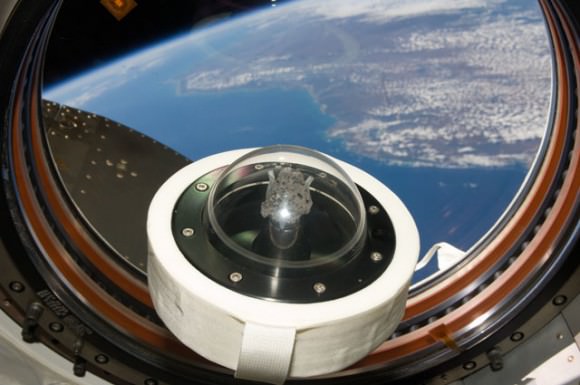
Of course, during this mission we celebrated the 40th anniversary of the Apollo 11 Moon landing. Fittingly, there was a Moon rock on board the ISS. The 3.6 billion year-old lunar sample was flown to the station aboard Space Shuttle mission STS-119 in April 2009. NASA says the rock, lunar sample 10072 serves as a symbol of the nation’s resolve to continue the exploration of space. It will be returned on shuttle mission STS-128 to be publicly displayed.
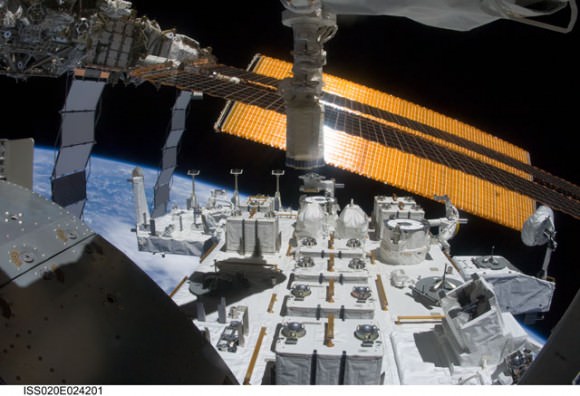
Here’s a view of the newly installed “front porch” of the Kibo lab, which is actually the Japanese Experiment Module – Exposed Facility (JEF). This platform will hold experiments designed to work outside the protective confines of the station, exposing them to the space environment. The JEF was installed by the astronauts during this mission.
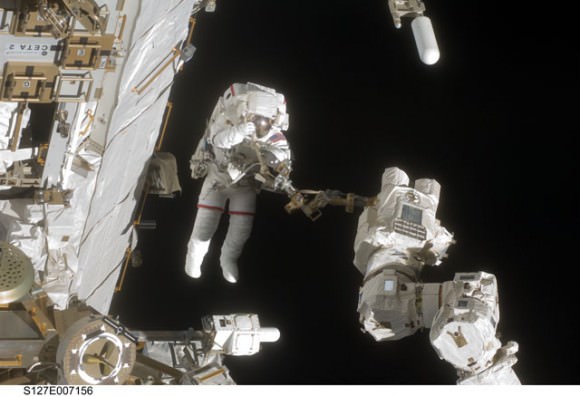
During the second STS-127 spacewalk, astronaut Dave Wolf worked outside bringing the Linear Drive Unit (LDU) and two other parts to the station’s External Stowage Platform 3 for long-term storage. Wolf is near the end of Canadarm2, which is anchored on the ISS.
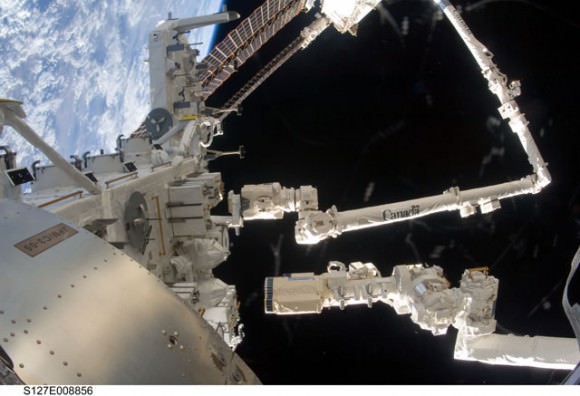
Speaking of the robotic arms, here’s a view of both the space station and space shuttle robotic arms as seen from inside the Kibo laboratory. A portion of the Japanese Experiment Module – Exposed Facility is also visible. The blackness of space and Earth’s horizon provide the backdrop for the scene.
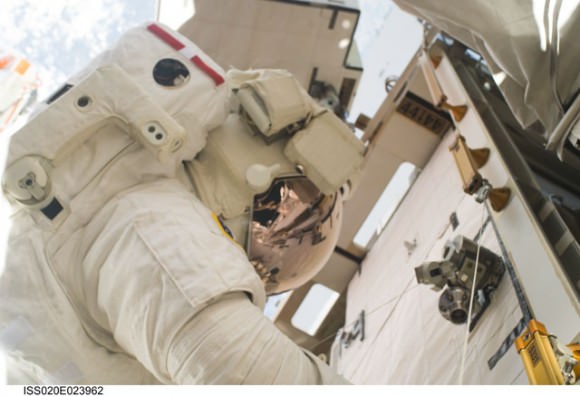
Astronaut Tom Marshburn makes his second spacewalk on July 24, along with Christopher Cassidy, out of frame. Eleven other astronauts and cosmonauts remained inside the International Space Station and the shuttle while the two astronauts worked outside.
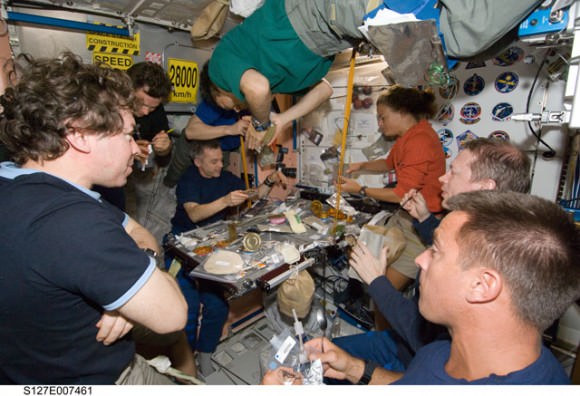
In total, there were 13 astronauts on board the ISS, a record for the amount of astronauts in one vehicle. Pictured, clockwise from bottom right, are astronauts Christopher Cassidy and Mike Barratt, with Russian Federal Space Agency cosmonaut Roman Romanenko, an unidentified crew member, Japanese Aerospace Exploration Agency astronaut Koichi Wakata (floating above), Canadian Space Agency astronauts Robert Thirsk and Julie Payette, European Space Agency astronaut Frank De Winne, and astronaut Christopher Cassidy. Either out of frame or not clearly seen are astronauts Mark Polansky, Doug Hurley, Dave Wolf, Tim Kopra and Tom Marshburn, plus Russian Federal Space Agency cosmonaut Gennady Padalka.
This screen shot shows the ISS as seen as Endeavour departed from the station on July 28. The views of both the ISS and shuttle were stunning. We’ll post the high-resolution versions when they become available. Notice the shadow of the space shuttle on the space station solar arrays! Amazing!
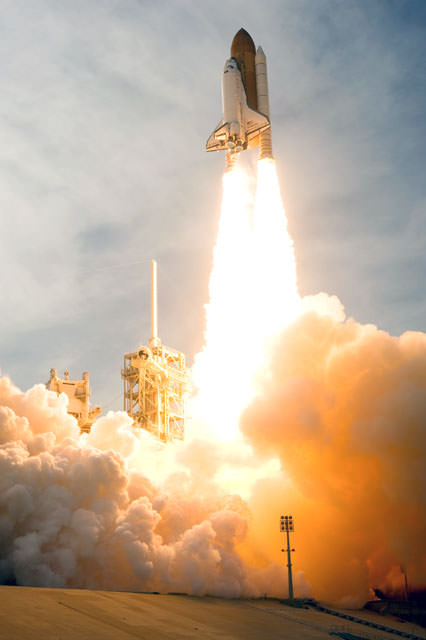
And now we’re back to the beginning of the mission. Liftoff for the STS-was at 6:03 p.m. (EDT) on July 15, 2009 from launch pad 39A at NASA’s Kennedy Space Center. The storm clouds stayed far enough away so that Endeavour and her STS-127 crew finally on its sixth attempt. Watch a replay of the launch here.

